Miniature gramophone leads procession of portable players
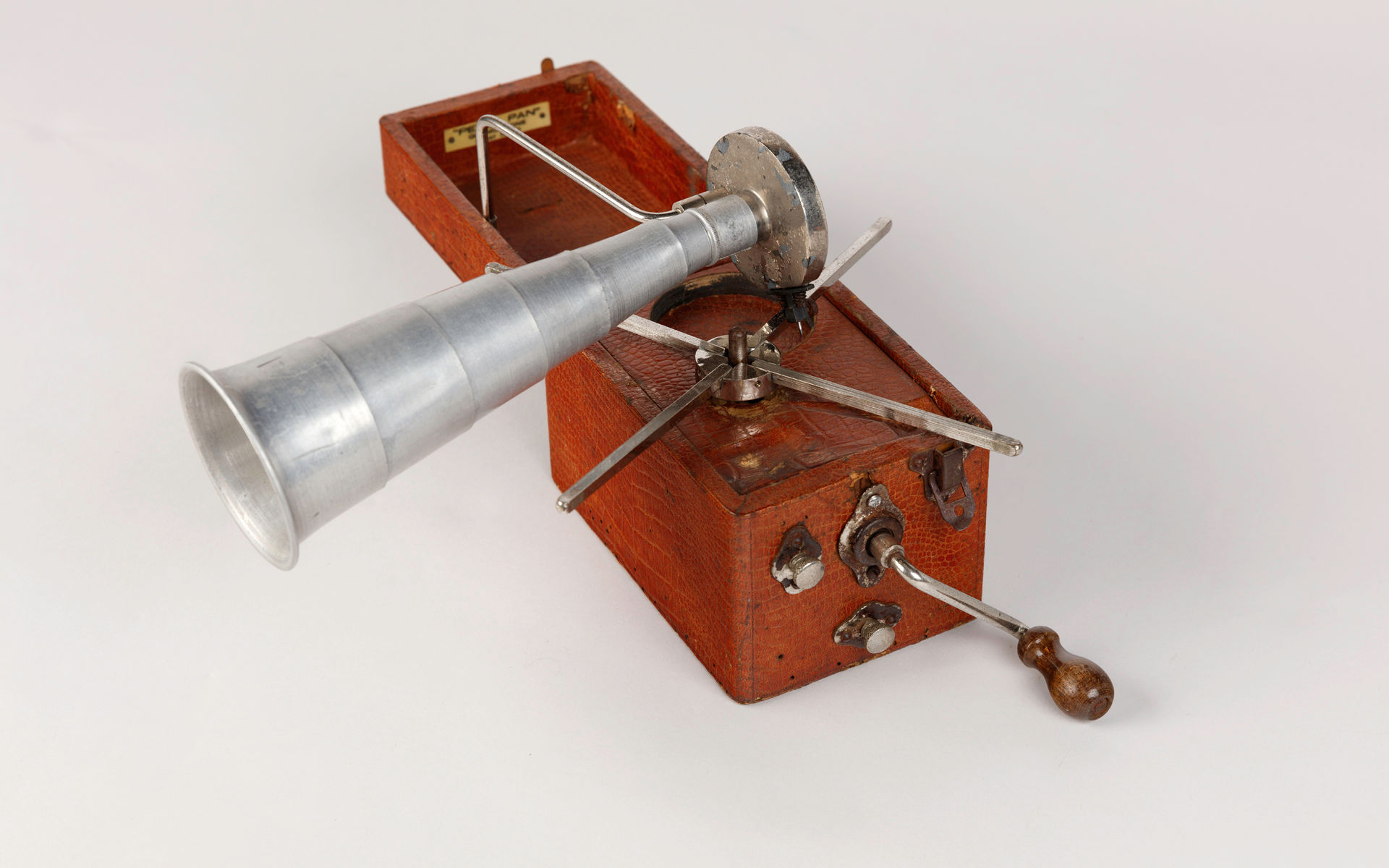
Peter Pan Gramophone
Nowadays most people would think of a portable music player as a smartphone or perhaps a dedicated device such as an MP3 player. A century ago however, portable music players looked rather different.
During the 1920s there was an explosion of different portable gramophones entering the market in a range of novel designs and configurations. The gramophone and the disc records it played had only been around for about 30 years since its invention by Emile Berliner in the early 1890s. Portable gramophones first appeared around 1910 and were typically suitcase-style devices with a full turntable and an integrated speaker horn. A well-known early example is the Decca portable gramophone, often called the Trench Decca as it was used by allied troops during the First World War [1]. Because you still had to carry around your collection of bulky shellac records, the smaller the player could be, the better.

Peter Pan Gramophone [1968.17] Museum of Transport and Technology (MOTAT).
The Peter Pan portable gramophone was invented by Frederick Ferris in the United Kingdom in the early 1920s. Ferris patented his Improved Gramophone in 1923 in the UK and around the world. The Peter Pan Gramophone Company Limited was founded by Ferris in 1923 to manufacture and distribute the Peter Pan. It was the first of a new type of portable gramophone referred to as 'camera gramophones' or simply 'cameraphones' because, when packed down, they resembled the portable box cameras of the time, for example the Kodak Brownie.
Despite its small size and minimalistic components, the Peter Pan was touted as having a good tone quality rivalling that of a full-size cabinet machine[2][3]. Newspaper advertisements from late 1923 show the Peter Pan was being sold in music shops throughout New Zealand for around £4/10s, approximately $540 in today’s money[4]. The popularity of portable gramophones during the 1920s is evident as the Peter Pan Gramophone Company had to actively pursue patent infringements of similarly designed camera gramophones[5]. The company wound up in 1929.
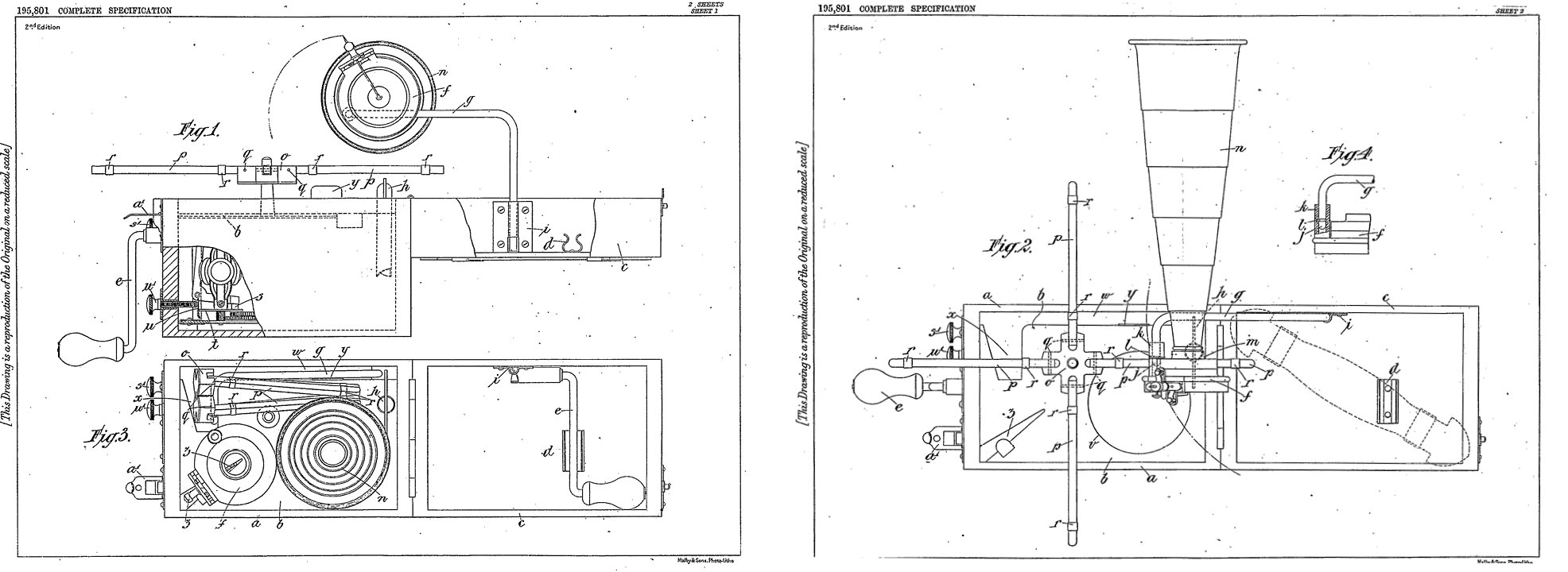
Schematic drawings from Frederick Ferris’ original patent [6]
The Peter Pan Gramophone Company developed several versions of the Peter Pan. This example in MOTAT’s collection is the first model and features the telescopic horn/tonearm. Later models featured further improvements, such as an integrated folding speaker horn and full tonearm.
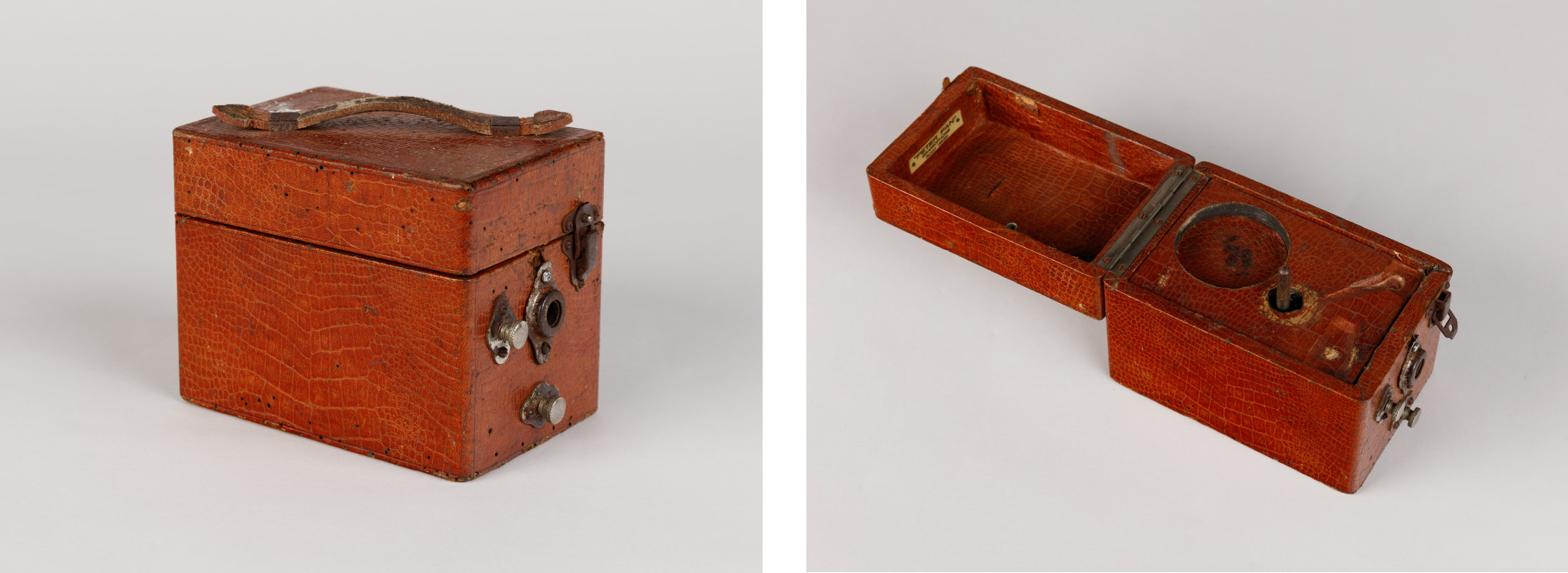
Motor box for Peter Pan Gramophone [1968.17] Museum of Transport and Technology (MOTAT).
The Peter Pan’s main improvements were in its miniaturisation and portability when compared to standard gramophones of the time. The entire machine breaks down into component parts, which are lightweight and collapsible where possible. This allows all the components to be securely packed away into the main box that also houses the motor and operating mechanisms. The ability of the Peter Pan to separate out like this provides us with an excellent opportunity to examine how the components of a gramophone function together.
The Peter Pan gramophones are powered by a clockwork motor made by Thorens, Switzerland. An internal spring mechanism is wound up using a removable crank handle. The potential energy stored in the spring is then released through the motor and turns the central drive spindle. The motor operates at a constant 78 revolutions per minute, which is limited by a governor. Two knobs on the front of the box control the playback. One is the main brake to stop and start the player, the other fine tunes the speed of rotation.

Folding turntable, collapsed (left) and open (right). Peter Pan Gramophone [1968.17] Museum of Transport and Technology (MOTAT).
The detachable turntable has four spokes that fold down to support the record disc. The central hub of the turntable fits snugly onto the driving spindle of the motor. The turntable can accommodate up to a 12-inch diameter disc.
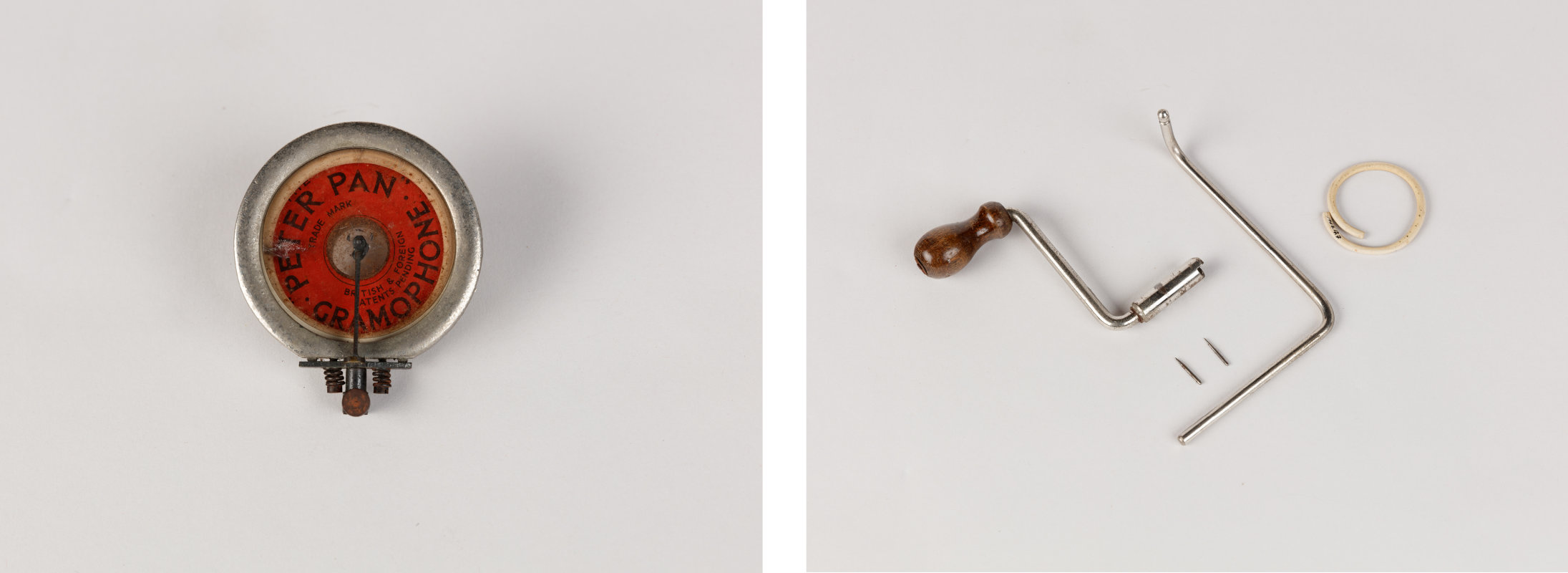
Peter Pan Gramophone Parts (left to right): Sound Box, Crank handle, Needles, Support Arm, Gasket [1968.17] Museum of Transport and Technology (MOTAT).
The soundbox is the key component for reproducing sound from a record. It consists of a diaphragm, stylus-bar, and needle. When in operation, the needle rests on the record disc and follows the groove in the record as the turntable rotates it. The oscillations in the groove are transferred into vibrations in the needle. These mechanical vibrations are carried up the stylus-bar to the diaphragm, which converts the vibrations into pulses in the air and thus produces audible sound. This process in effect mimics the propagation of sound in the human ear via the interaction of the malleus bone (hammer) and eardrum, though the process is reversed. The diaphragm of the soundbox is believed to be made of a thin mica disc held in place by rubber gaskets. Mica, a mineral that forms in thin sheets, was commonly used in early gramophone diaphragms through to about the 1930s and was chosen for its durability and flexibility.
The needle needs replacing regularly due to the point wearing down with use. There are a range of different needle types made from various materials. In the case of MOTAT’s Peter Pan, a standard steel needle appears to have been used. These needles had an operational life of only about five minutes. Manufacturers would often recommend changing such needles after playing each side of a record, because extended use of worn needles reduces the sound quality produced and can accelerate the wear of the record itself. Some needles were made of more durable metals such as tungsten. These were known as ‘semi-permanent’ needles and could withstand playing many records. Non-metallic needles referred to as ‘fibre’ or ‘thorn’ needles used plant-based materials such as bamboo and wood. Typically, fibre and thorn needles cause less wear on records than metal needles, but they are often less responsive. However, the right setup with a soundbox designed for use with non-metallic needles can produce excellent results.
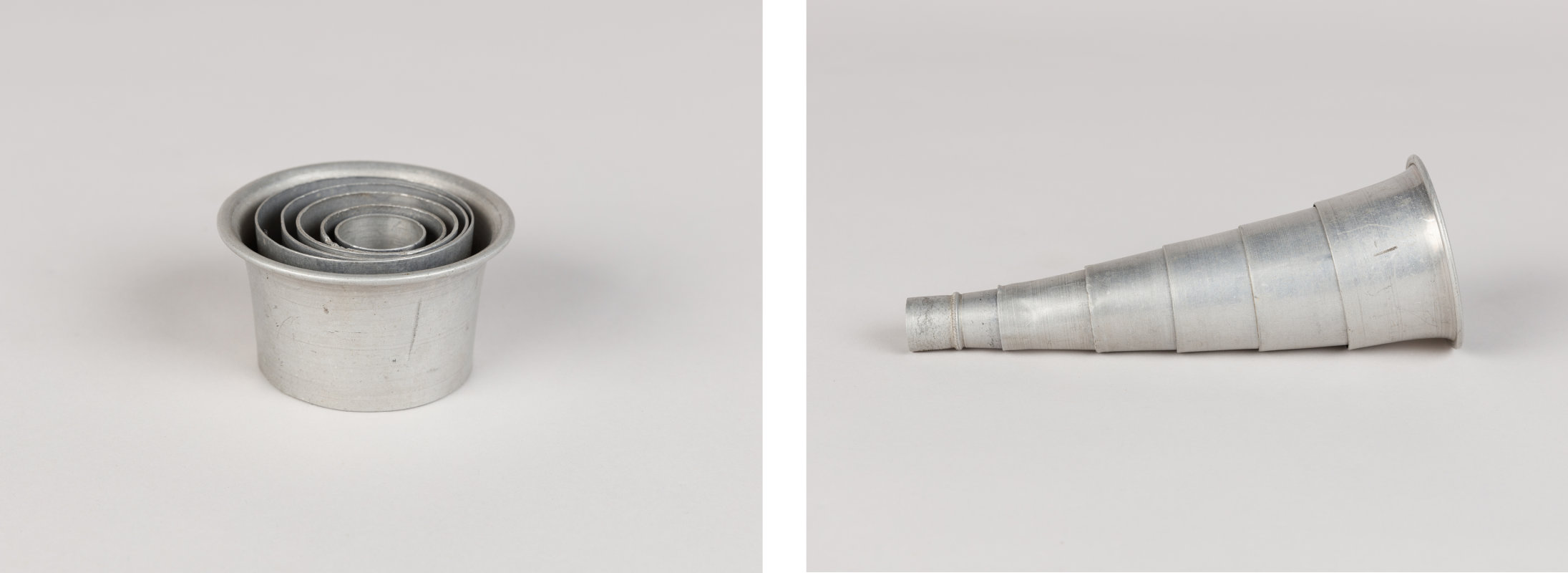
Speaker Horn collapsed (left) and extended (right) Peter Pan Gramophone [1968.17] Museum of Transport and Technology (MOTAT).
Generally speaking, a gramophone speaker horn connects to the soundbox via a tonearm and acts to amplify the sound. The horn puts additional load on the diaphragm, requiring it to move a larger volume of air than the soundbox alone. This draws more energy from the motor via the record-needle interface. A larger horn moves a larger volume of air and thus produces a louder sound. The expanding shape of the horn (typically conical or exponential) also allows for more efficient transfer of energy from the soundbox, providing a gradual expansion into the open air. It also focuses the sound in a particular direction, which has an amplifying effect.
The Peter Pan’s speaker horn consists of six frustoconical (a cone that has its tip cut off) parts that telescopically fit together, and there is no separate tonearm. The whole horn can be collapsed down into the size of its largest segment for storage.
The reproducer assembly (needle, soundbox, horn) attaches to a support arm connected to the lid of the motor box. Then, with the spindle and crank handle also fitted, the unit is fully assembled and able to be operated.
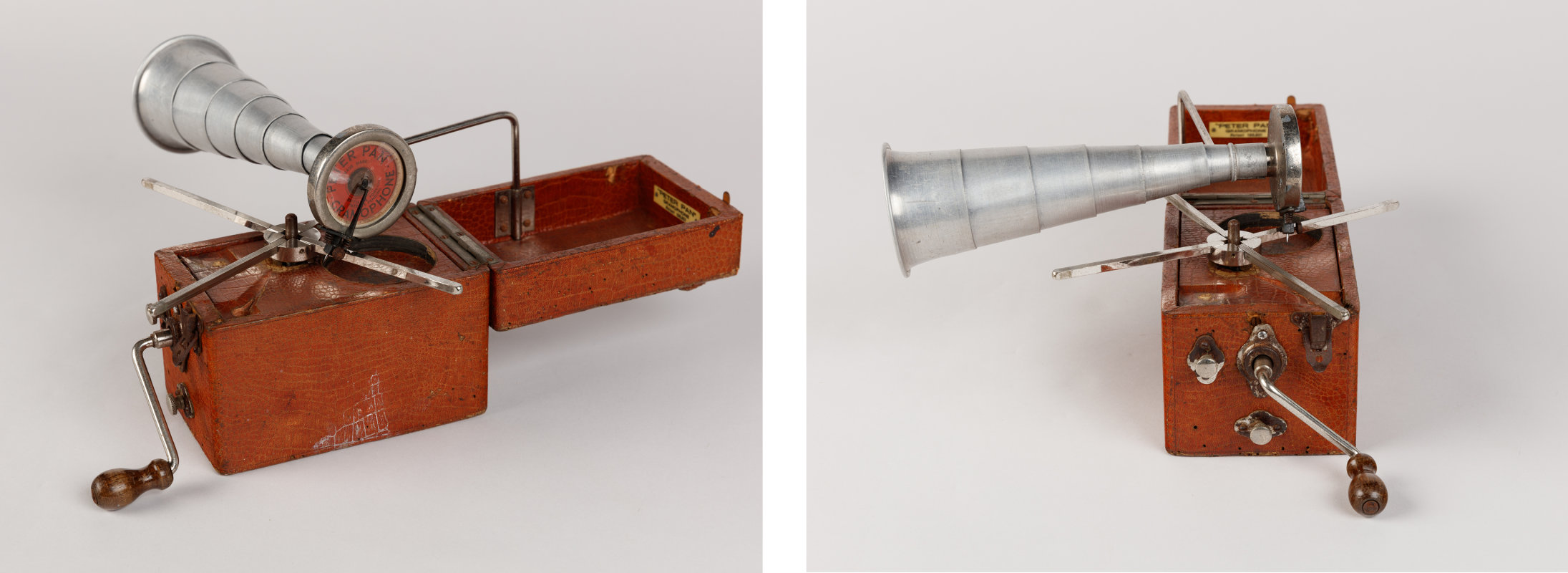
Peter Pan Gramophone fully assembled. Peter Pan Gramophone [1968.17] Museum of Transport and Technology (MOTAT).
Conservation of the Peter Pan Gramophone
In preparation for displaying the Peter Pan in Te Puawānanga Science and Technology Centre, the gramophone had several conservation problems that required a varied treatment plan.
An in-depth visual examination was conducted using a magnifying glass. The following conservation problems were noted during the examination. There was general wear and tear from prior handling. Accumulation of surface dust and dirt all over the object. All metal components were mildly corroded. Borer exit holes were present on top of the lid, confirming borer infestation inside the box. Evidence of frass inside the box suggested active infestation. There was flaking of the chrome layer on the rear side of the sound box. One of the screws was missing from the metal bracket used to hold the crank handle, which resulted in the crank handle hanging loose at one end.
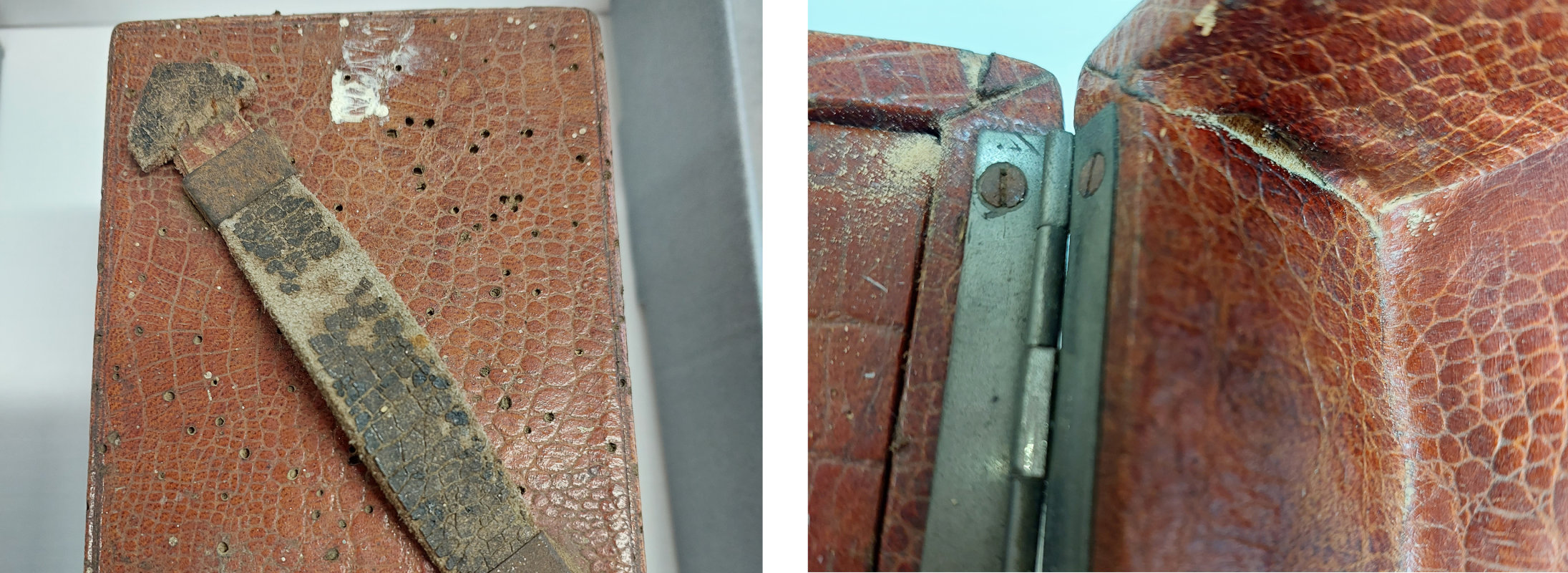
Left: Borer exit holes present on top of the lid. Peter Pan Gramophone [1968.17]. Right: Frass present inside the box. Peter Pan Gramophone [1968.17]. Museum of Transport and Technology (MOTAT).
A written and photographic documentation was carried out after the visual examination. The object was kept in the freezer for four weeks to kill and eliminate the borer. Prolonged exposure to freezing temperatures for few weeks is enough to eliminate the borer cycle. Removal of frass was carried out using brush vacuum and locally treating the split in the leather cover/lining inside the lid by injecting no-borer liquid treatment as a preventative measure to ensure any remaining borer was dead.
A gentle surface cleaning inside and outside of the box was completed using a museum vac followed by aqueous cleaning with deionized water. Gentle rust removal was carried out mechanically (as much as possible) followed by tannic acid application to protect all metal components from any further corrosion. The chrome layer on one side of the sound box was consolidated using an acrylic adhesive. The turntable was cleaned and polished with a chrome polish. A new screw was fitted to fasten the loose end of the metal bracket into the wooden box. The leather handle was conditioned using leather polish to give it some flexibility. All other components were cleaned with deionized water.

Left: Replaced screw on top of the metal bracket. Peter Pan Gramophone [1968.17]. Right: Flaky chrome layer after consolidation. Peter Pan Gramophone [1968.17] Museum of Transport and Technology (MOTAT).
With the condition of the gramophone stabilised and most components in working condition, the Peter Pan gramophone is now ready for display in Te Puawānanga Science and Technology Centre.
Peter Pan Gramophone [1968.17] Museum of Transport and Technology (MOTAT), Content created by Connor Crawford Photography
Story by Callan Bird, Curator – Technology (MOTAT) and Deeksha Bhardwaj, Conservator (MOTAT).
Story edited by Nicola Jennings, Senior Curator – Technology (MOTAT).
Published: April 2024
Endnotes
[1] Holmes, T. (2013). The Routledge Guide to Music Technology. Taylor & Francis, UK. https://www.google.co.nz/books/edition/The_Routledge_Guide_to_Music_Technology/qvCNAQAAQBAJ?hl=en&gbpv=1
[2] Trade exhibits. (1923, October 24). Gisborne Times, LIX(9649), 7. https://paperspast.natlib.govt.nz/newspapers/GIST19231024.2.48
[3] Advertisements. (1925, August 27). Waimate Daily Advertiser, XXIV, 1. https://paperspast.natlib.govt.nz/newspapers/WDA19250827.2.2.2
[4] Reserve Bank of New Zealand Te Pūtea Matua. (2024, April 17). Inflation calculator. https://www.rbnz.govt.nz/monetary-policy/about-monetary-policy/inflation-calculator
[5] Public notices. (1923, October 25). New Zealand Times, L(11659), 3. https://paperspast.natlib.govt.nz/newspapers/NZTIM19231025.2.22.2
[6] Ferris, F. (1923, April 12). Improved gramophone (UK Patent No. GB195801A). European Patent Office. https://worldwide.espacenet.com/publicationDetails/biblio?CC=GB&NR=195801A&KC=A&FT=D&ND=3&date=19230412&DB=EPODOC&locale=en_EP
Sources
Advertisements. (1923, December 15). Hawke's Bay Tribute, XIII(309), 4. https://paperspast.natlib.govt.nz/newspapers/HBTRIB19231215.2.22.1
Advertisements. (1925, September 3). Waimate Daily Advertiser, XXIV, 3. https://paperspast.natlib.govt.nz/newspapers/WDA19250903.2.3.2
Advertisements. (1928, March 21). Evening Star, (19821), 8. https://paperspast.natlib.govt.nz/newspapers/ESD19280321.2.82.8
Board of Trade, UK. (1923-[1932]). Company No. 188385 (BT 31/27783/188385). Records of the Board of Trade and of successor and related bodies, The National Archives, Kew, Richmond, England. https://discovery.nationalarchives.gov.uk/details/r/C4983202
Companies Registration Office. (1929, 24 December). Companies Act, 1929. The London Gazette, (33563), 8393. https://www.thegazette.co.uk/London/issue/33563/page/8393
Gyula, J. (2018). The gramophone that soldiered on. Science Museum, UK. https://blog.sciencemuseum.org.uk/the-gramophone-that-soldiered-on/
Library of Congress. (2018, November 9). The gramophone. https://www.loc.gov/collections/emile-berliner/articles-and-essays/gramophone/
Ward, C. (2005). How to make & 'dope' triangular bamboo needles (fibres) for playing 78rpm records. WardWorks. https://www.wardworks.org.uk/Gramophone/index.html
Wilson, G. (1932). Gramophones: Acoustic and radio. Gramophone (Publications) Ltd., London. https://images.cch.kcl.ac.uk/charm/liv/pubs/Gramophones.pdf
Wilson P., & Webb, G. (1929). Modern gramophones and electrical reproducers. Cassell and Company, Ltd. https://www.gramophonemuseum.com/images/People/Percy%20Wilson/PDF/percy-wilson-modern-gramophones-1929.pdf